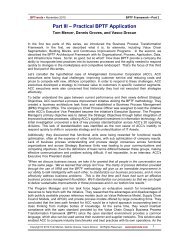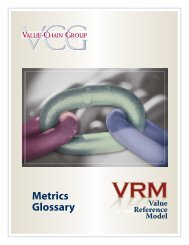BPTF Architecture Overview - Value Chain Group
BPTF Architecture Overview - Value Chain Group
BPTF Architecture Overview - Value Chain Group
- No tags were found...
You also want an ePaper? Increase the reach of your titles
YUMPU automatically turns print PDFs into web optimized ePapers that Google loves.
Copyright©2010<strong>Value</strong><strong>Chain</strong><strong>Group</strong>allrightsreserved|PartIBusinessProcessTransformationFramework4Thiscomplete,threedimensionalviewoftransformationdefineswhatparticularvaluestreammustundergotransformation,whatactionableitems(functions)areaffectedbyinthetransformation,andhow,overtime,thetransformedvaluestreamsmustevolve.Thefirstpartofthisthreepartarticleseriesdefineseachofthetransformationdimensionsandprovidesinsightsintohowtocompileacompleteandeffectiverepresentationofthetransformedbusinessprocess.<strong>Value</strong><strong>Chain</strong>SegmentationThis<strong>BPTF</strong>dimensiondefinesbusinessprocessesasconnectedvaluestreams.<strong>Value</strong>streamsincludeactivityflowwithexplicitinformationflow(calledinputsandoutputs),businessmetricsandtimelineassociatedwiththeflowinexecution(e.g.,durationoftheprocessfromonepointofI/Ohandofftoanotherpointinthesamevaluestream).Anexampleofavaluestreamis“ordertocash”,witheachactivityclearlydefined,theirI/Oconnectivitydefinedalongwithmetricsandtimelinessofeachtransactionwithintheprocess.<strong>BPTF</strong>Definition:<strong>Value</strong>Stream–anendtoendsetofactivities.Orderfulfillment,forexample,isavaluestreamforwhichtheinputistheorder,andtheresultisthedeliveryoforderedgoods.Orderentryisoneactivityinthecollectionofactivitiesthatconstitutetheorderfulfillmentvaluestream.Segmentation,bothoftheexternalmarketplaceandofanorganization’sinternalvaluestreams,isessentialtomaximizingtheefficiency,effectiveness,profitabilityandcustomersatisfactionratingsofmostorganizations.Therearemanyunfortunateandsometimesterminalexamplesoftheoppositeoutcomefororganizationsthathavenotunderstoodtheimportanceofsegmentation.Essentially,segmentationmeansthatonesizerarelyfitsall.Allcustomersarenotthesame(e.g.,businesscustomerversusconsumer),notallcustomersbuyinthesameway(e.g.,retailoutletversusInternetpurchasesite)andnotallproductsorservicescanbeprovidedusingthesameassetsinthesamefacility(e.g.,youdon’tmakenutsandboltsinachocolatefactorythatmixesnutsandnougat)!Thedifferentiateddemandsofthemarketplaceforproductsandserviceshasimplicationsforhowanorganizationsells,produces,deliversandsupportsthoseproductsandservices.Atypicalglobalcompanyencompassesdifferingbusinessesandmultiplestrategicbusinessunits(SBUs).Fromahighlevelperspective,allSBUshavesimilarities.Forexample,theyallperformfinance,sales,marketing,andotherbasicfunctionalactivities.ButamoredetailedexaminationwillrevealthatsomeofthosefunctionalactivitiesdifferbySBUdependinguponthemarketeachSBUservesandthebusinessobjectivesofeach.<strong>Value</strong>streamsegmentationsimplytranslatesexternalmarketrequirementsintokeyinternaloperatingprocessrequirements.Theseprocessrequirementsmanifestthemselvesasphysicalorvirtualdifferencesinsitelocations,processes,systems,productionlayouts,leadtimes,qualityattributesandskillrequirements.Aneffectiveorganizationdevelopsamarketsegmentationmodelthatmeetsthespecificneedsofitsmarkets,customers,channels,productsandservices.Disciplinedvaluechainsegmentationenablescompaniestounderstandandspecifymorefullywhatexternallyfacingprocessesareneededintheprocessmodelingofthenextstepinthebusinessarchitectureroadmap.







